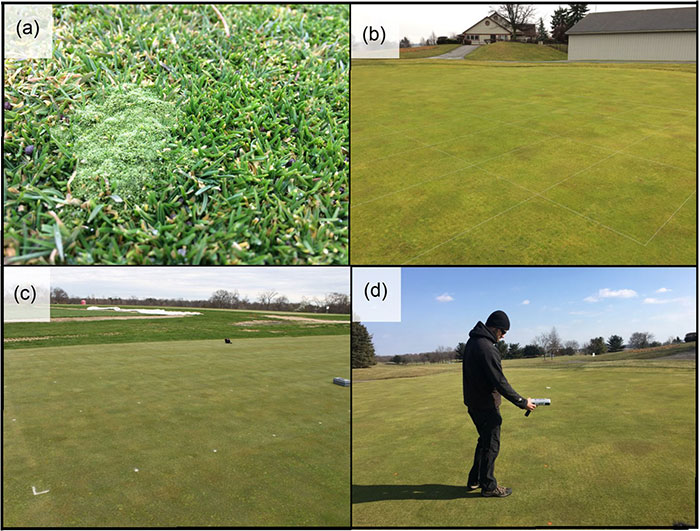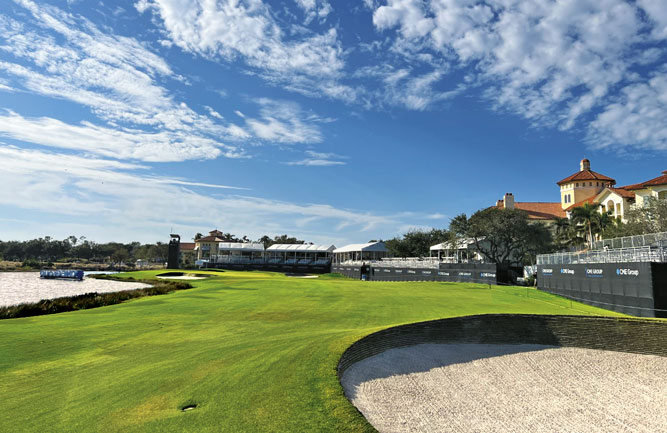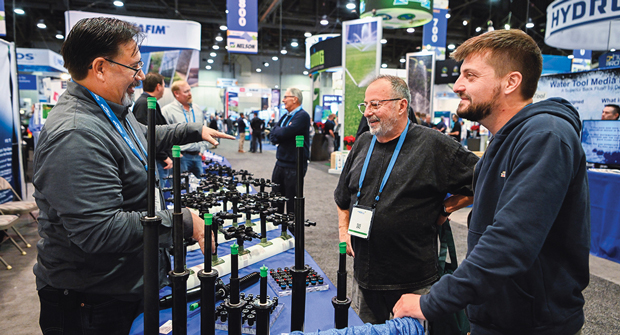How fine fescues aid in crabgrass weed suppression
Fine fescues, a group of low-input turfgrasses, have exhibited weed suppression. Smooth crabgrass is a ubiquitous, warm-season, grassy weed that outcompetes many cool-season turfgrasses in summer (9). The presence of summer annual weeds like crabgrass may decrease or nullify the ecosystem services provided by cool-season turfgrasses due to dying back in autumn or leaving bare soil until late spring.
Fine fescues require lower inputs than other cool-season turfgrasses due to improved resistance to drought, decreased fertilizer requirements, greater resistance to common diseases and the ability to adapt to shade (2, 6). Having fine fescue cultivars that can also consistently reduce crabgrass would help increase the usage of these beneficial turfgrass species.
Maintained as a golf course fairway, various cultivars of fine fescues were highly weed suppressive in New York State (2). Of the fine fescue taxon, Chewings fescue (Festuca rubra ssp. commutata; CH) and strong creeping red fescue (F. rubra ssp. rubra; ST) displayed the most robust weed suppression ability, while hard fescue (F. brevipila; HF) did not appear to have the same level of suppression. However, most of this research occurred more than 10 years ago and did not lead to improved cultivars. Other taxon included in our weed suppression research are slender creeping red fescue (F. rubra ssp. littoralis; SL) and sheep fescue (F. ovina, SH).
We need to confirm the previous results using diverse germplasm with genetic variability for weed suppression to aid our breeding efforts. Our objective was to screen for weed suppression abilities in 19 fine fescue accessions collected initially in Europe, at two distinct field locations, St. Paul, Minn., and West Lafayette, Ind., infested with smooth crabgrass (Digitaria ischaemum).
Field experiment
Field experiments were located at the Turfgrass Research Outreach and Education Center at the University of Minnesota in St. Paul and the William H. Daniel Turfgrass Research and Diagnostic Center at Purdue University in West Lafayette. Both fields were initially sprayed with glyphosate in the autumn of 2016 and in early April 2017 (2 pounds per acre, GlyphoMate 41, PBI/Gordon), then rototilled two days before planting to a depth of 2 inches in West Lafayette, and 2- to 4-inch depth in St. Paul. We removed plant residues immediately prior to planting in both locations.
Seventeen accessions originating from Europe were chosen based on their ability to reduce white clover (Trifolium repens) and annual bluegrass (Poa annua) root development in a preliminary study (4). In addition, we included two commercially available fine fescue cultivars: Navigator II ST and Beacon HF.
Fine fescue plants were transplanted on April 25, 2017, in St. Paul and April 27, 2017, in West Lafayette. Each field experiment consisted of four replications of 20 plots (one crabgrass only control and 19 plots with fine fescues) in a randomized complete block design. Each plot was 1-foot by 1-foot, separated from other plots with a 1-foot border. Plugs of fine fescue entries were planted in a 3-by-3 pattern (nine plugs total per plot), spaced equally, and occupied an area of 4 feet2 within the plot.
During spring 2017, plots were mowed once per week with a walk-behind rotary mower at 3.5 inches with clippings returned. We applied urea (0.5 pounds per 1,000 feet2) to the field areas in June 2017 and stopped mowing when we saw crabgrass seedhead formation in the majority of the plots.
Data collection
Smooth crabgrass seedheads. In August 2017, the presence of smooth crabgrass seedheads was rated in St. Paul with a scale of 1 to 9, where 1 indicates 100 percent seedhead density based on the crabgrass-only control plot, and 9 indicates plots without crabgrass seedheads.
End of season smooth crabgrass biomass. At the end of September 2017, crabgrass biomass was estimated for each plot at both locations. An 8-inch diameter circle template was placed at three different fine fescue plug locations within each plot, and the entire crabgrass leaf biomass was harvested within the ring. The samples were dried for a minimum of 48 hours at 221 degrees F before being weighed.
Plant height: In August 2017, the height of each unmown fine fescue plug (nine plugs per plot) was measured.
Smooth crabgrass seedling density. In spring 2018, a circle template of 8-inch diameter was centered on the middle fine fescue plug within each plot. The number of crabgrass seedlings was assessed, and we measured the size of the fine fescue plug. Because the size of the fine fescue plug varied among entries, we calculate crabgrass seedling density for the area without turf.
Equation 1:
Densitycrabgrass= Sumcrabgrass ∕ (Areacircle−Areaturf) (1), where densitycrabgrass is crabgrass seedling density, sumcrabgrass is the total number of crabgrass seedlings in the 8-inch diameter circle, areacircle is the circle area and areaturf is the area of the fine fescue plug. The difference in area circle and area turf gives us the unoccupied soil surface area from which crabgrass had the potential to emerge.
Across the two locations, the environmental conditions and crabgrass populations were not the same, so we analyzed all data collected from St. Paul and West Lafayette independently.
Furthermore, there was significant entry-by-location interaction for characteristics evaluated.
We averaged the three crabgrass biomass measurements and the nine fine fescue plant height subsamples before analysis for each plot. Data were analyzed using a mixed model with fine fescue taxon or entry as fixed effects and replicated as a random effect for both locations.
For taxon analyses, comparisons to the control plots were performed using a Dunnett’s test, and statistical differences (P < .05) were obtained. For the entry analysis, multiple mean comparisons were performed with a Student’s t-test, and statistical differences were obtained (P < .05).
Similar analyses were performed for the fine fescue areas, except that the controls (empty plots) were removed; multiple mean comparisons for the taxon and entries were performed with a Student’s t-test, and statistical differences were obtained (P < .05).
Effect of taxon
Taxon had a significant effect on smooth crabgrass seedhead rating in St. Paul and end-of-season biomass in both locations (Table 1). Both SL and CH displayed significantly reduced smooth crabgrass seedhead presence in St. Paul compared to the control plots. Strong creeping red fescues also reduced smooth crabgrass seedheads, but this reduction was not significant compared to the control. Smooth crabgrass biomass was lower than the control for all taxa in
St. Paul, whereas, in West Lafayette, this was only the case for SL (Table 1).
In earlier research at Ithaca, N.Y., several fine fescues cultivars were evaluated for weed suppression, but only four were SL (1). Our results indicate that SL cultivars and/or accessions may be more weed suppressive than previously thought, which is primarily due to a combination of under-representation in turfgrass trials and misidentified germplasm collections.
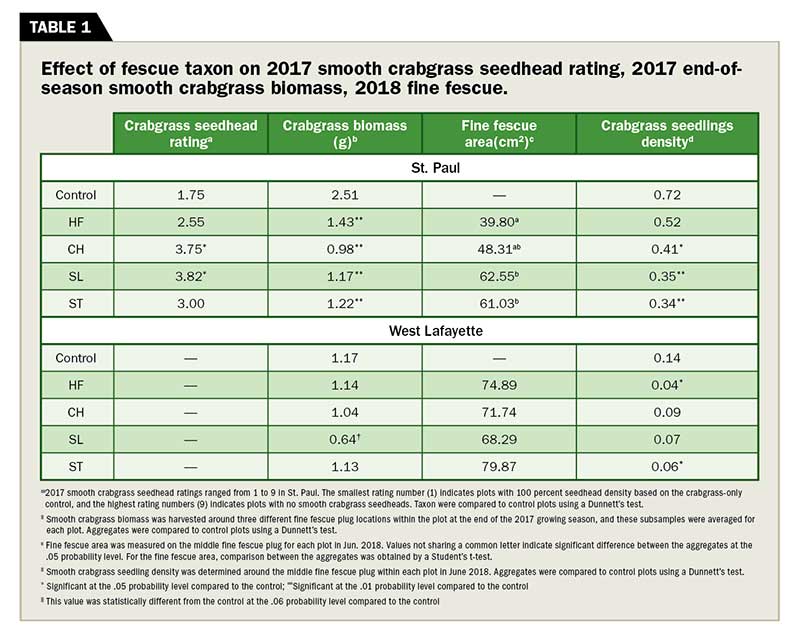
Chart: Florence Breuillin-Sessoms
A significant effect of taxon on crabgrass seedling density was observed for both locations. Seedling density was significantly lower for CH, ST and SL (compared to the control) in St. Paul, whereas HF led to a nonsignificant reduction in seedling density (Table 1).
In West Lafayette, smooth crabgrass seedling density was significantly lower than the control for ST and HF. While CH and SL reduced seedling density to some extent, it was not significantly different from the control. Similarly, HF spread more slowly (lower turf area) in St. Paul but was similar to the red fescue taxa in West Lafayette.
Hard fescue growth differences may be due to the effects of a longer growing season in Indiana. Data obtained from the National Turfgrass Evaluation Program (NTEP) showed that Minnesota (two locations in St. Paul) possessed lower fine fescue spring green-up ratings compared to more southern states such as Illinois (Carbondale location). The spring green-up rating for HF was 2.3 and 3.6 in St. Paul and 6.8 in Carbondale, Ill. (5). This difference was not as dramatic for the CH (4.8-5.1 for Minnesota and 6.8 for Illinois), ST (4.8 for Minnesota and 6.7 for Illinois) and SL (4.2-5.6 for Minnesota and 7.3 for Illinois).
In a relatively more southern location such as Carbondale, HF and SF green-up ratings were similar to the other red fescues (CH, SL, ST). Fine fescues are cool-season grasses adapting to the northern two-thirds of the United States, yet we know little on taxon-specific performance within certain areas within this zone. Fine fescues seem to establish quicker in the more southern regions (longer spring and fall seasons, faster spring green-up) of temperate climates, especially HF.
The improved green-up of HF in warmer climates could explain why HF reduced smooth crabgrass density in West Lafayette but not in St. Paul. Turfgrasses that green up more quickly or are denser in spring should reduce crabgrass infestation as they shade the soil surface in spring, resulting in a reduction in crabgrass-seed light interception (9).
The light requirement for smooth crabgrass germination is not well studied and inconclusive (8), but other Digitaria species such a D. ciliaris, D. longiflora and D. sanguinalis require light for germination, or their germination is increased by light (3, 8). As such, the reduction in crabgrass density could be from allelopathy, plant competition or both, and this needs further study.
We did not include the single SH entry in this experiment in either aggregate or taxa analysis. In this experiment, SH plots were among the entries with the smallest area and highest crabgrass density at both locations. Since there were differences between HF entries in this experiment, and there is tremendous genetic variation among F. ovina (7), there may be an opportunity to improve the weed suppression potential of SH.
Effect of entry
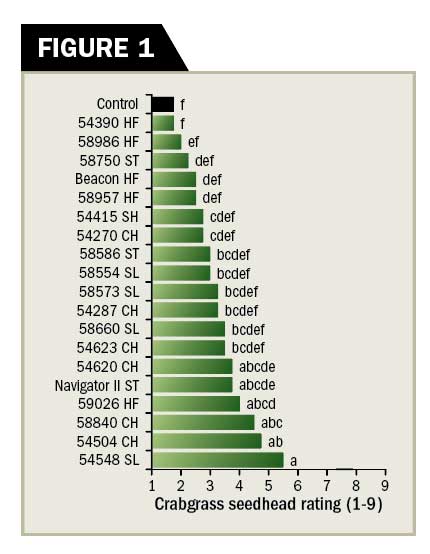
Chart: Florence Breuillin-Sessoms
We observed a significant entry effect for smooth crabgrass seedhead rating, end-of-season biomass, seedling density and fine fescue areas in both locations. The highest seedhead rating (most suppressive) belonged to accession 54548 SL in St. Paul (Figure 1). Furthermore, the HF, CH, SL and ST entries were not significantly different from the control plots. Only Navigator II ST, 59026 HF, 58840 CH, 54504 CH, 54548 SL and 54260 CH displayed a higher seedhead rating (low crabgrass incidence) in St. Paul.
We recorded fine fescue plant height within 24 hours of the crabgrass seedhead rating. Because the fine fescue plants were not mowed to allow crabgrass seedhead development, plant height was used to proxy growth during the 2017 growing season. We performed a correlation analysis (data not shown) between smooth crabgrass seedhead rating and the fine fescue height to examine if entries that grew taller led to greater crabgrass suppression. Entries in St. Paul displayed a positive and significant correlation between fine fescue plant height and the crabgrass seedhead rating (r = .31, P < .0001). These data suggest that plant height and/or vigor may play a role in the smooth crabgrass biomass suppression observed in 2017.
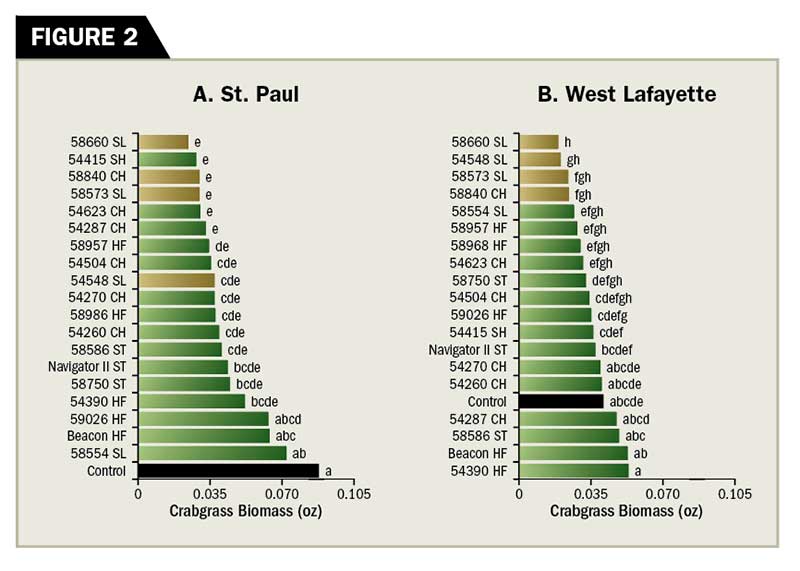
Chart: Florence Breuillin-Sessoms
Accession 58660 SL had the lowest end-of-season smooth crabgrass biomass observed in St. Paul and West Lafayette (Figure 2). In St. Paul, the control plots displayed the highest smooth crabgrass biomass on average, but this was not the case for the West Lafayette location; in fact, accession 54390 HF had the highest smooth crabgrass biomass in West Lafayette, and Beacon HF presented the highest smooth crabgrass biomass across both locations. Accessions 58840 CH, 58573 SL, 58660 SL and 54548 SL were significantly lower than the control plots at both locations and were associated with the least smooth crabgrass biomass.
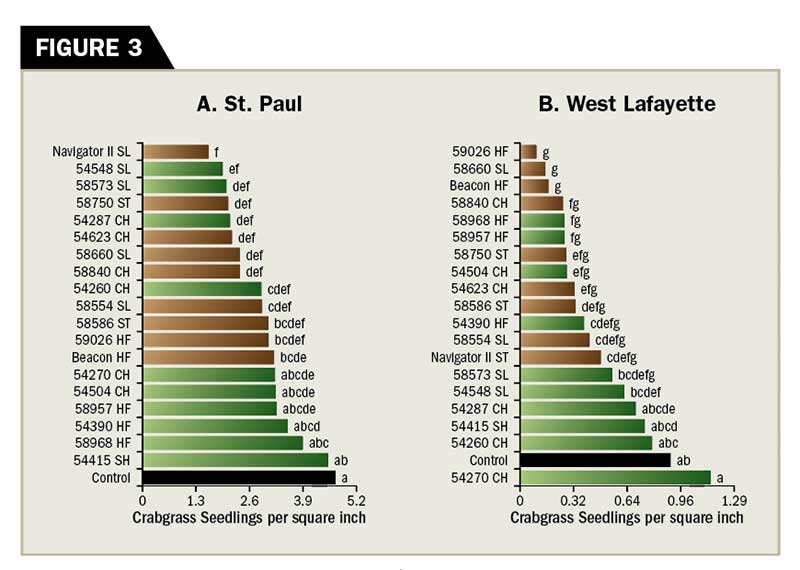
Chart: Florence Breuillin-Sessoms
In St. Paul, the lowest smooth crabgrass seedling density was observed with Navigator II ST and 59026 HF inWest Lafayette (Figure 3). The control plots in St. Paul and entry 54270 CH in West Lafayette had the highest smooth crabgrass seedling density. Navigator II ST, 58586 ST, 58750 ST, 58660 SL, 58554 SL, 54623 CH, 58840 CH, Beacon HF and 59026 HF had lower crabgrass seedling density than the control plots at both locations. Entry 58660 SL and Beacon HF covered the greatest areas in St. Paul and West Lafayette, respectively (Figure 4).
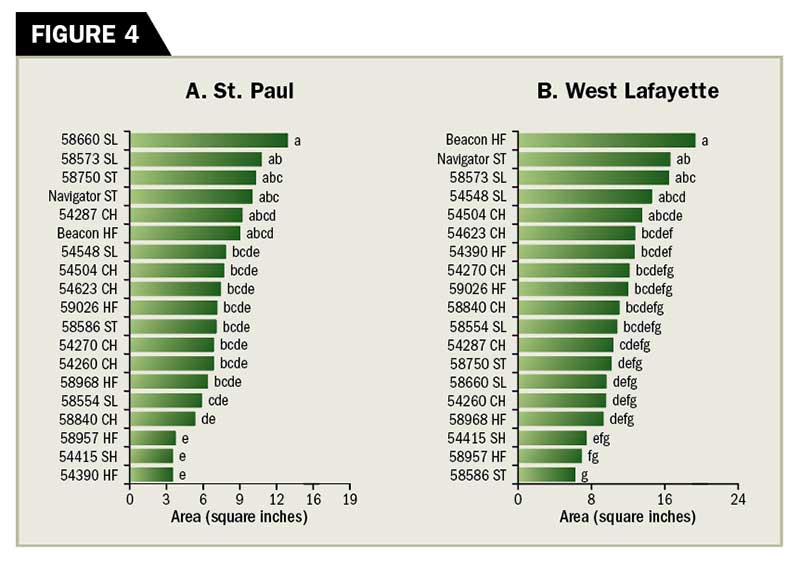
Chart: Florence Breuillin-Sessoms
Conclusion
Our results revealed a significant degree of variability among accessions of the same taxon on the measured crabgrass parameters. We found several CH entries (3 of 6) reduced seedhead presence, whereas most SL entries (3 of 5) led to reduced end-of-season crabgrass biomass. Interestingly, smooth crabgrass seedling emergence was affected by ST, SL, CH and HF entries at both locations, with a more substantial effect of HF entries in West Lafayette.
In this field experiment, differences in correlations (data not shown) between fine fescue growth (plant height and plot area covered) and smooth crabgrass development (biomass and seedling density) for St. Paul and West Lafayette emphasize the presence of a strong location effect. The differences may be partly due to growing season length, growing degree day accumulation, rainfall and snowfall between the locations. Future studies should more closely examine the effect of location and abiotic factors, such as temperature on the magnitude of fine fescue weed suppression.
Overall, while our results confirmed the weed suppressive ability of some CH and ST entries, they also point to the need for a greater understanding of how this suppression works and what role environmental conditions play in the response, especially in HF.
Our results confirmed previous reports that the F. rubra taxa are more crabgrass suppressive than HF. Results also indicated that there is significant variability between the entries within each taxon, including within HF. Chewings fescue and slender creeping red fescue (F. rubra ssp. littoralis, SL) displayed the most robust ability to suppress smooth crabgrass. However, not all CH or ST entries are weed suppressive, and some HF entries are as weed suppressive as the best CH and ST.
Results suggest further opportunities for plant breeders to develop new weed suppressive cultivars for low-input turfgrass systems. The variation in crabgrass suppressive ability among fine fescue taxa indicates that if there is no selection for the trait, it could be lost or become a weak trait within a cultivar.
Research takeaways
- Festuca rubra taxa are more crabgrass suppressive than F. ovina.
- There is considerable variability in weed suppression across entries within each fine fescue taxon.
- Opportunities exist for plant breeders to develop new weed suppressive cultivars.
- Future studies should aim to separate allelopathic effects from plant competition.
Acknowledgments
The authors wish to acknowledge the funding support by the National Institute of Food and Agriculture, USDA, Specialty Crop Research Initiative under award number 2017-51181- 27222. Thank you also to William Meyer, Ph.D., Rutgers University, for sending germplasm for screening. The authors would also like to thank all the undergraduate students and Geoffrey Schortgen for their participation in collecting the data presented.
Author Contributions
Information in this article was adapted from Breuillin-Sessoms, F, Petrella, D P, Trappe, J M, Mihelich, N T, Patton A, & Watkins E. Field evaluation of weed suppression in fine fescue (Festuca spp.). Crop Science. (2021);61:2812–2826. https://doi.org/10.1002/csc2.20506. For more information, contact Florence Breuillin-Sessoms, Ph.D., University of Minnesota, fsessoms@umn.edu.










